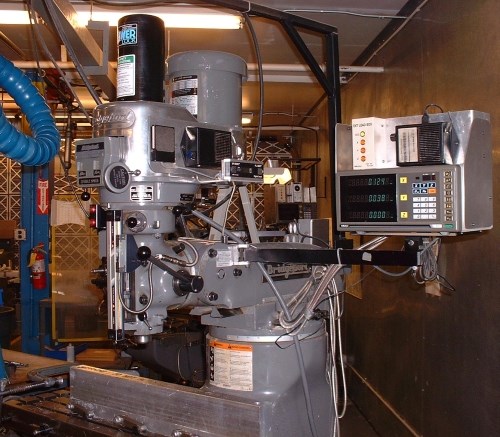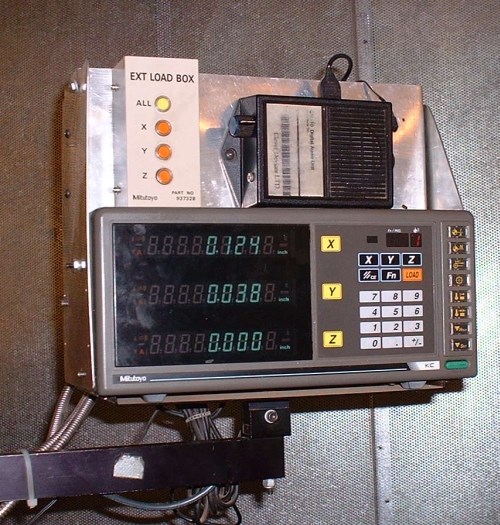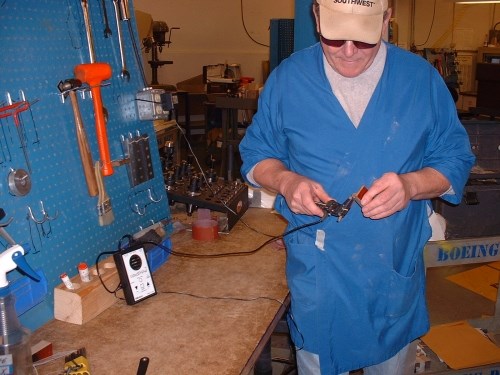Adapting And Advancing
Assistive technologies for machinery and shop equipment allow blind workers at this machine shop to assume more advanced, independent roles in the production of aerospace components for Boeing.
Share


It probably comes as no surprise to learn that there is a machine shop in Seattle, Washington, that has been a Boeing supplier for 50 years. What may be surprising is the fact that many of the parts manufactured in this shop are produced by machinists who are blind. Some are even deaf and blind.
The shop is part of the Seattle Lighthouse for the Blind, a not-for-profit agency that has provided employment, support and training for visually impaired folks since 1918. The shop primarily funds itself through its sales to Boeing and the U.S. government, which are its two principal customers. None of its machines are donated, and all income from sales of machined parts is channeled to shop upgrades and the development of technologies to assist blind workers in the use of machine tools and related equipment.
These assistive technologies, combined with thorough training from sighted and, in some cases, blind machinists, have greatly expanded the capabilities of the shop's visually impaired workforce. In fact, some of the shop's 40 blind workers can set up a machine tool, run a job and perform in-process inspection on their own. Though a machine shop environment is inherently dangerous, the Lighthouse has a very good track record for worker safety.
Overcoming obstacles to get parts out of the door on time and on spec is an everyday occurrence in a machine shop. This shop takes the exercise of overcoming obstacles to a higher level.
Subtle Differences
The Lighthouse machine shop is dubbed the “Boeing Department.” It looks and sounds much like any other machine shop, though there are subtle differences. Its aisleways are a bit wider, and customary yellow safety lines have been built up slightly with concrete to help guide a person's cane. Some work orders are printed in a larger-than-typical font size, while others are embossed with Braille symbols for fingertip translation. Additional lighting brightens machine workstations and illuminates cutting tools in action. The din of whirring spindles and buzzing light ballasts often includes the “beep” of a modified edge finder signaling that it has contacted a part or fixture during job setup. Digital voices, beckoned with the touch of a button, can be heard relaying part measurements, machine axis positions or critical part program information to machine operators. Some workers talk to each other without saying a word.
These differences have nothing to do with how a part is machined, but rather how workers obtain feedback from their facility and equipment. The messages are the same; only the mode of communication is different.
Part to Print
Each job at the Lighthouse starts just as it would at any other shop—with a work order. However, work orders at the Lighthouse are modified per the machine operator's visual capability. For those with limited sight, all that may be required is an increase of text font size made possible by off-the-shelf text enlargement software. For workers with no vision, another piece of software converts on-screen text to Braille symbols, and then sends those symbols to an embossing printer to output a Braille work order.
Next comes machine set up. Self-sufficiency, in terms of a blind operator setting up a machine on his or her own, requires communication of a number of variables. One of these variables is machine axis position. The Lighthouse leaped over this hurdle by combining digital readout (DRO) and digital voicing technologies.
The Lighthouse worked with Mitutoyo (Aurora, Illinois) in the development of the Voiceman portable voice output device. The Lighthouse uses the Voiceman to voice position information that typically would only be shown as numerals on a DRO. The Lighthouse has fitted DROs to manual milling machines, shears, cutoff saws and custom measuring tables. Workers push buttons on compact control units to receive the position feedback.
The Voiceman can also be wired to Mitutoyo calipers, micrometers and other gages. Voiced measurement information allows blind operators to perform their own in-process and first-article inspection at a machine. Similarly, a number of Bridgeport knee mills use the Voiceman to relay head angle from digital levels mounted on the side of machine heads.
To further aid in machine set up, the Lighthouse modified edge finders by replacing the indicator lights with small speakers that emit an audible signal whenever the devices come in contact with a vise or part. Height gages and tool presetters have been customized in the same manner.
Adapting CNCs
The Lighthouse has a number of Bridgeport computer numerical control (CNC) machine tools with DX32 PC-based control. A PC-based control allows easy integration of a number of assistive software tools. For example, the Lighthouse modified an off-the-shelf text-reading software to create what it calls CNC Voice99, software that voices text shown on a machine control's screen. Once a part program stored on a floppy disk is loaded into the control, the software allows an operator to hear the job number, all necessary setup information, the tools that are required and other information that would normally be read from the control screen.
The Lighthouse is in the process of installing a dedicated Bridgeport 1000 vertical machining center (VMC) with fourth-axis capability and vacuum table to replace two slab mills in the production of tapered fuselage shims machined from T3 aluminum sheet. The thin side of each of these shims is typically 0.010 inch, but the thick side can range from 0.030 to 0.250 inch.
A second computer added to this machine runs software that enables workers to program a new shim job by inputting only five pieces of information—thickness of thin and thick edges, shim width and length, and material nominal thickness. From this information, the computer determines the proper angle of the fourth-axis table and automatically enters the shim size data where needed in the part program. There is no need to set X or Y zero positions or measure tools. Seattle University helped the Lighthouse in refining the assistive software. Setup on this machine takes only 5 minutes, versus 1 to 2 hours on the slab mills. In addition, the cycle time has been cut in half.
A Good Part is a Good Part
The Lighthouse has a history of providing 99.96 percent good parts to Boeing, so it must be doing something right. In fact, the assistive technologies allow the shop to do it right with folks one might not expect to find working in a machine shop. In the end, a plane assembler doesn't care who machined the parts being assembled, so long as the parts all fit together. A good part is a good part, no matter the level of machinist visual ability.
Related Content
Shop Tour Video: You've Never Seen a Manufacturing Facility Like This
Explore Marathon Precision’s multi-process approach to manufacturing, where blacksmiths and hand-forged dies meet state-of-the-art CNC machining. Discover how restoring classic muscle cars and building custom art projects creates a dynamic shop culture — and draws top talent to this unique and innovative metalworking facility.
Read MoreWorkholding Fixtures Save Over 4,500 Hours of Labor Annually
All World Machinery Supply designs each fixture to minimize the number of operations, resulting in reduced handling and idle spindle time.
Read MoreFinding the Human Connections in Human Resources
By working with its employees and its community, Win-Tech has found unexpected opportunities for employee retention and recruitment.
Read MoreHow I Made It: Amy Skrzypczak, CNC Machinist, Westminster Tool
At just 28 years old, Amy Skrzypczak is already logging her ninth year as a CNC machinist. While during high school Skrzypczak may not have guessed that she’d soon be running an electrical discharge machining (EDM) department, after attending her local community college she found a home among the “misfits” at Westminster Tool. Today, she oversees the company’s wire EDM operations and feels grateful to have avoided more well-worn career paths.
Read More






























.png;maxWidth=300;quality=90)







